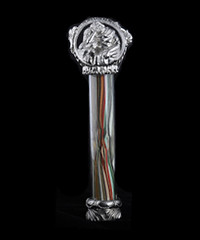Keeping kosher with recipes for Passover and other kosher food recipes is a great way to stay linked to your Jewish heritage while instilling religious values in your children. But if you're finding to feel even closer to the old country, chances are it's going to involve some Yiddish. Read on for some excellent Yiddish words and phrases relating to food, including words that have become common among English speakers.

Bagel: Originating in Krakow, Poland, the bagel first appeared to compete with the bublik - a denser, drier ring of dough. It became tradition for observant Jews to bake bagels after the Sabbath on Saturday evenings, as bagels take less time to make than most other bread products.
Yiddish
Blintz: Crepe-like pastries with sweet filling, usually cheese. Unlike crepes, blintz pancakes are made with yeast. Blintzes are often served during Chanukah and Shavuot.
Challa: Bread common on Shabbat dinners, although forbidden in Passover recipes.
Chazzer: This describes a pig - or, more frequently, person that eats like a pig. There's also chazzerei (pig's feed, or junk food) and the expression a chazer bleibt a chaser ("a pig remains a pig").
Er est vi noch a krenk: "He eats like he just got over an illness."
Er frest vi a ferd: "He eats like a horse."
Essen: Part of many other phrases, essen means "to eat." We also see it in ess gezunterhait ("eat in good health") and essen mitik (to eat midday).
Fleishig: A meat product.
Fressen/fress: Fressen describes a more intense form of eating - pigging out. There's also the American-born fressing (gourmandizing) and umzitztiger fresser (a freeloader who only wants to eat your food).
Gedempte flaysh: An unknown - or "mystery" - meat.
Gelt: Though it can mean actual money, gelt is usually used to describe the chocolate coins favorite during Chanukah.
Hak flaish: Chopped meat.
Kasheh: Food-wise, kasheh is soft cereal or porridge, but it can also be used to describe a confusing mess.
Kreplach: Meat-filled dumplings reminiscent of ravioli. In other settings, kreplach can be used to mean something worthless.
Latke: Even favorite among gentiles, latkes are potato pancakes served most often during Chanukah. The pancakes are cooked using oil, which for some represents the enduring oil flame that inspired the holiday.
Lox: A historic friend of the bagel, lox is a salmon fillet cured with a brining solution. Lox was popularized in the United States by Jewish immigrants from Eastern Europe.
Milchig: A milk product.
Nosh: A widely used verb to describe snacking. Typically, you nosh on a nosherie (snack food).
Parveh: Food that isn't milchig (milk) or fleishig (meat). It's also thought about neutral.
Pesach: This is an easy one - Pesach is the Yiddish term for Passover. Because of the extra dietary restrictions, there are many Pesach recipes created specifically for the holiday.
Schmaltz: Describes a type of fat or grease, usually melted fat from a chicken. In contemporary usage, schmaltz can also describe over-the-top sentimentality.
Schmeer (or schmear): A spread on a bagel, such as cream cheese.
Shtark gehert: easily "strongly heard," this phrase is used to classify smelly food.
Traif: Non-kosher food. A traifnyak is a person who eats traif, or who is ordinarily loathsome.
Wen ich ess, ch'ob ich alles in dread: Literally, this phrase means "when I am eating, I have all things in the ground," but you can substitute "I don't care about anything else" for that last part.
Zee est vee a feigele: "She eats like a bird." Probably because she doesn't know any good kosher recipes!
Fun With Kosher Recipes - Yiddish Words and Phrases![The Yiddish Policemen's Union: A Novel (P.S.) [Paperback]]( http://ecx.images-amazon.com/images/I/513mrWlOzcL._BO2,204,203,200_PIsitb-sticker-arrow-click,TopRight,35,-76_AA300_SH20_OU01_.jpg)

